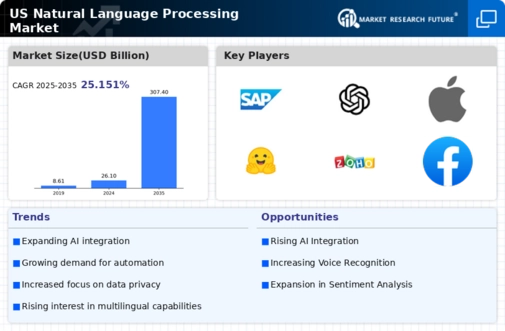Increased Investment in NLP Startups
The natural language-processing market is witnessing a surge in investment directed towards startups specializing in NLP technologies. Venture capitalists and private equity firms are increasingly recognizing the potential of NLP solutions to address complex language-related challenges across industries. In 2025, investments in NLP startups are expected to exceed $1 billion, reflecting a growing confidence in the market's future. This influx of capital is likely to foster innovation, leading to the development of novel applications and services that enhance user experiences. As the ecosystem of NLP startups expands, the natural language-processing market is set to evolve, offering diverse solutions that cater to the needs of various sectors.
Advancements in Machine Learning Algorithms
Recent advancements in machine learning algorithms are significantly influencing the natural language-processing market. Innovations such as deep learning and neural networks have enhanced the capabilities of NLP applications, enabling more accurate language understanding and generation. For instance, the introduction of transformer models has revolutionized how machines process language, leading to improvements in tasks like sentiment analysis and language translation. The market is projected to expand as these technologies become more accessible and integrated into various applications. As organizations leverage these advancements, the natural language-processing market is poised for substantial growth, with estimates suggesting a compound annual growth rate (CAGR) of around 25% over the next few years.
Rising Need for Enhanced Customer Experience
The natural language-processing market is significantly driven by the rising need for enhanced customer experience. Businesses are increasingly adopting NLP technologies to analyze customer feedback, automate responses, and personalize interactions. This trend is particularly evident in sectors such as retail and finance, where understanding customer sentiment is crucial for maintaining competitive advantage. Research indicates that companies utilizing NLP tools for customer engagement can improve satisfaction rates by up to 40%. As organizations strive to create more meaningful connections with their customers, the natural language-processing market is likely to see continued growth, with businesses investing in solutions that facilitate better communication and understanding.
Growing Demand for Automation in Business Processes
The natural language-processing market is experiencing a notable surge in demand for automation across various business processes. Organizations are increasingly recognizing the potential of NLP technologies to streamline operations, enhance productivity, and reduce operational costs. According to recent data, the automation of customer service through chatbots and virtual assistants is projected to grow by approximately 30% annually. This trend indicates a shift towards more efficient communication channels, allowing businesses to handle customer inquiries swiftly and effectively. As companies seek to optimize their workflows, the natural language-processing market is likely to benefit from this growing inclination towards automation, positioning itself as a critical component in the digital transformation journey of enterprises.
Integration of NLP with Other Emerging Technologies
The natural language-processing market is being propelled by the integration of NLP with other emerging technologies such as artificial intelligence (AI), big data analytics, and the Internet of Things (IoT). This convergence allows for more sophisticated applications that can analyze vast amounts of unstructured data, providing valuable insights and enhancing decision-making processes. For example, combining NLP with big data analytics enables organizations to extract actionable intelligence from customer interactions and social media. As these technologies continue to evolve and interconnect, the natural language-processing market is expected to expand, offering innovative solutions that address complex challenges across various industries.

























Leave a Comment